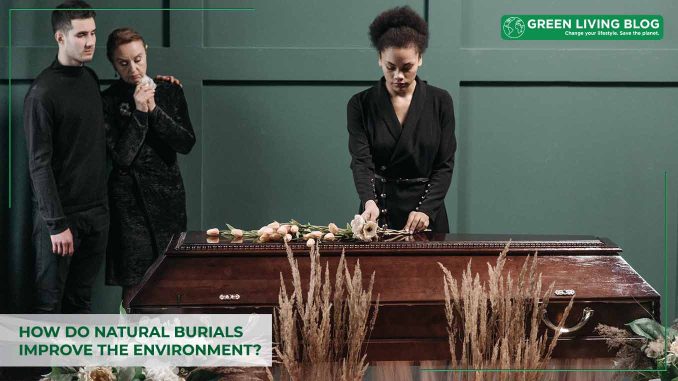
2024 may well be the year in which we pass the internationally agreed threshold of a global temperature rise of 1.5°C above pre-industrial levels. Although that barrier won’t officially be considered breached until the 1.5°C limit has been exceeded over several years, this is still likely to be a very significant – and very unwelcome – milestone.
Of course, we’re already trying to change the way we live our lives to both reduce the levels of greenhouse gases we produce and protect our endangered natural environments. But people are also now becoming aware that the way we die – or, more accurately, the way our passing is marked – can also have a seriously deleterious effect on the planet.
As a result, green funerals are becoming an increasingly popular option. But what are they and do they really make a difference?
What are green Funerals?

Green funerals and green burials, sometimes known as natural burials offered by burial sites such as Tithe Green Natural Burial, are designed to have the least possible negative impact on the environment, in many cases even producing a net positive outcome. They can do this in several ways, including:
- Eliminating or reducing the use of harmful chemicals and non-biodegradable materials – many traditional coffins, caskets, urns and shrouds contain materials that can damage the soil and local environment as they decompose, while the chemicals used to embalm a body (including formaldehyde) can also poison the
- Reducing emissions produced during cremation – this can be as much as 400kg of CO2 per body, while 16% of the UK’s mercury emissions derive from vaporised tooth fillings.
- Supporting and boosting local ecosystems and land conservation – burials and interments in natural burial grounds are often accompanied by planting trees and/or wildflowers that encourage pollinators and other beneficial wildlife.
How does a green Funeral differ from a traditional Funeral?

Many of the elements that make up a green funeral can be remarkably similar to those of a traditional one. There can be a ceremony with songs and readings attended by family and friends (which can be religious or non-religious according to the beliefs of the
deceased), there can be a burial or interment, and there can be a wake or other form of celebration afterwards.
The idea is simply to minimise the environmental impact at each stage by making choices that avoid the materials and activities that might create greenhouse gases or harm the environment. This can include only using biodegradable coffins and urns – made out of cardboard, wool, willow and other natural materials – and not having the body embalmed.
But there are other, less obvious benefits to opting for an eco-friendly funeral because according to the Green Burial Council, the cost of a green funeral can also be significantly less than a traditional one. This can be a result of using less exotic coffins and caskets or avoiding embalming, while many natural graveyards also charge less for a gravesite than conventional cemeteries.
Interestingly, when we think of a traditional funeral, what we’re usually referring to is a relatively recent phenomenon. Before the industrial era, most burials would have been ‘natural’, simply because the harmful materials we so often use today would not have been around.
In other words, what is often referred to as a ‘green’ or ‘natural’ burial is actually far more traditional than the alternative!
How are green Funerals better For the environment?

It is estimated that each year enough embalming fluid to fill eight Olympic-sized swimming pools and more steel than was used to build the Golden Gate Bridge are buried in the USA as part of the funeral industry. Add in the quantities of CO2 being sent into the air through cremations and it’s clear that carrying on in the same way is unsustainable.
But green funerals and natural burials are not just about avoiding a bad result. They can also, as mentioned earlier, benefit environments when combined with positive actions that support and boost local flora and fauna.
By allowing a body to naturally decompose into the soil, it improves its quality by providing essential nutrients and preserving nitrogen levels. Backed up by actions such as planting trees and creating wildflower meadows, this isn’t just supporting nature, it’s also helping to create beautiful environments that are far more enjoyable and life-affirming to visit and remember a lost loved one than traditional graveyards and cemeteries.
If you’re concerned about your environmental impact after your death, be sure to make your wishes known by letting those close to you know, leaving instructions in your will or even making all the arrangements in advance.
Because as green funerals enter the mainstream, there are fewer excuses for making the way we die as bad for the planet as the way we live the majority of our lives.
![]()
Author Profile

- Eco Warrior by day, Eco Blogger by night trying to get the eco balance right.
Latest entries
 Best practicesMarch 25, 202510 Green Tips to Live a More Sustainable Lifestyle
Best practicesMarch 25, 202510 Green Tips to Live a More Sustainable Lifestyle Green Expert GuidesMarch 12, 2025Flexible Solar Panels for Trucks: Benefits of Smarter Solar Energy Solutions for the Trucking Industry
Green Expert GuidesMarch 12, 2025Flexible Solar Panels for Trucks: Benefits of Smarter Solar Energy Solutions for the Trucking Industry Green Home GuidesFebruary 27, 2025How Sustainable Heating is made simple with Bioethanol Fireplaces
Green Home GuidesFebruary 27, 2025How Sustainable Heating is made simple with Bioethanol Fireplaces BusinessFebruary 25, 2025The Rise of Sustainable Pharmaceutical Packaging Reviewed
BusinessFebruary 25, 2025The Rise of Sustainable Pharmaceutical Packaging Reviewed





Leave a Reply
You must be logged in to post a comment.